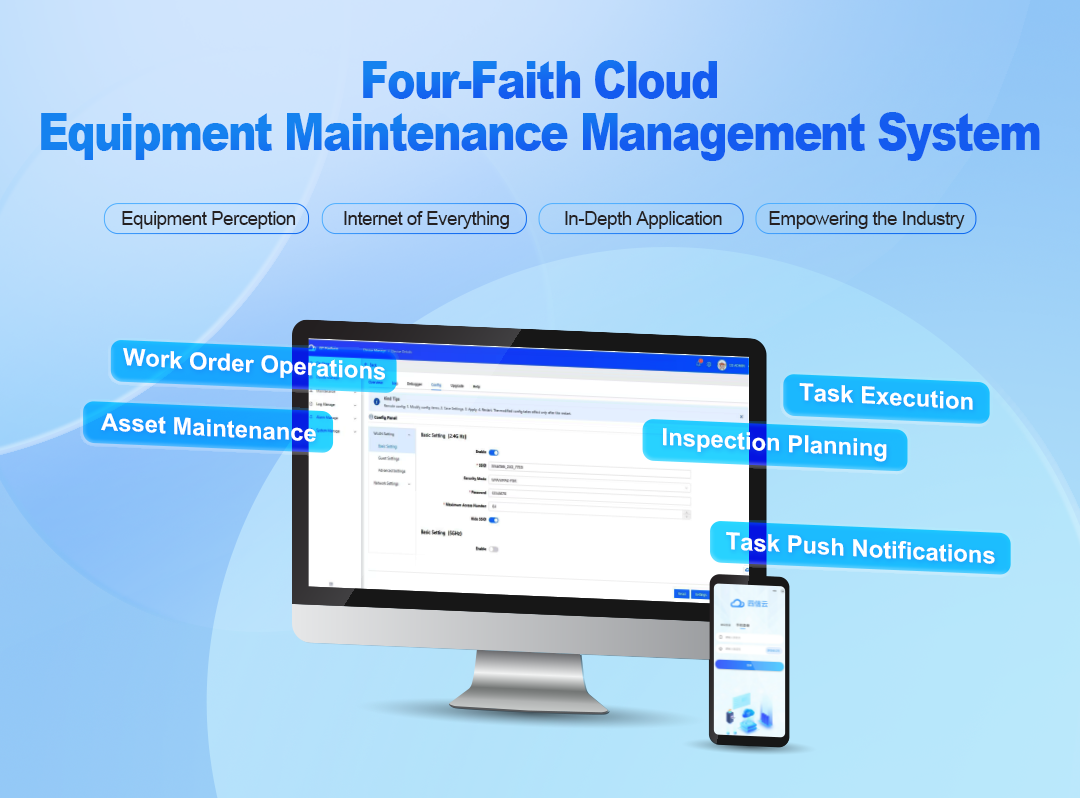In today's manufacturing industry, equipment is the core element of enterprise production and the cornerstone of enterprise competitiveness.
As enterprises continue to expand, the number of equipment grows rapidly, and traditional manual management methods can no longer meet enterprise needs. The emergence of equipment management systems fills this market gap. Their goal is to achieve dynamic zero-failure operation of equipment, real-time monitoring of equipment status, operation conditions, and maintenance records, thereby providing decision support and data analysis for enterprises.
To address the pain points in the equipment management process, the Four-Faith Cloud - Equipment Maintenance Management System has been launched. By establishing a complete process of daily inspections, equipment repair requests, response handling, and maintenance records, it achieves integrated lifecycle supervision of equipment. The system standardizes equipment inspection and maintenance management, detects and prevents equipment failures, supports management decisions with multi-dimensional business data analysis, ensures healthy operation of equipment, and guarantees production safety and efficiency.

Industry Pain Points
Difficult to Trace Equipment Records
In traditional supervision models, when equipment issues arise, companies need to check the historical inspection, repair, and maintenance records of the equipment. This process often involves sifting through extensive paper records, consuming significant time and sometimes resulting in incomplete records, making it difficult for companies to trace and track the equipment's history.
Challenging to Ensure Production Safety
Under traditional management methods, inspection workers typically use paper forms to record inspections, leading to inefficiency and inaccurate data. In the event of equipment failure, timely response is not possible, compromising production safety.
Difficult to Respond to Fault Reports
The lack of intelligent analysis tools results in untimely dispatching and repairs, with poor communication causing delays. Consequently, repairing faulty equipment can take a considerable amount of time.
Difficult to Manage Equipment Storage
Without a unified maintenance platform, managers cannot promptly understand equipment inventory and usage, affecting equipment repairs and project production, and potentially causing financial losses for the enterprise.
Difficult to Execute Maintenance Plans
Managers often fail to implement systematic maintenance plans, with task assignment and execution lacking proper control, making it hard to carry out maintenance work effectively.
Four-Faith Cloud - Equipment Maintenance Management System
The Four-Faith Cloud - Equipment Maintenance Management System centers on the full lifecycle of equipment, focusing on maintenance, repairs, and inspections. It collects basic and operational data of the equipment, performing real-time statistical analysis to help enterprises move away from paper-based processes and achieve digital equipment management.
Key aspects of equipment maintenance include equipment inspections, repair requests, and equipment repairs.
Equipment Inspections
Maintenance personnel can create periodic inspection tasks based on the schedule. The system will send reminders for due inspections, and inspectors can directly fill in the inspection results according to preset inspection items, forming both maintenance and inspection records.
Equipment Repair Requests
When a maintenance worker identifies an issue, they can directly submit a repair request via a mobile device. Work orders are quickly generated and assigned, allowing repair personnel to navigate to the destination promptly, thereby improving overall work efficiency.
Equipment Repairs
Administrators and maintenance personnel can view the progress and results of work orders directly on their mobile devices without needing to inquire via phone or messaging apps, making the entire work order management process visible and controllable.
Inspection and work order notifications support third-party collaborative applications such as DingTalk, Feishu, and WeChat Work, ensuring timely message reception and faster handling.
System Advantages
Increase Operational Efficiency
Intelligent work order management with full-process visualization allows for real-time information dissemination and retrieval, making inspection and maintenance more convenient.
Enhance Transparency
Maintenance personnel and administrators can view the progress and results of tasks anytime, anywhere, reducing communication costs between parties.
Reduce Operational Costs
By assigning tasks through the system and handling them via mobile applications, the workload of maintenance personnel is reduced, repair cycles are shortened, and repair costs are lowered.
Extend Equipment Lifespan
Maintaining, managing, and monitoring equipment helps identify and resolve issues, reducing the likelihood of faults that could shorten equipment lifespan.
Improve Equipment Utilization
Collecting and analyzing equipment data helps identify and address operational bottlenecks, enhancing equipment efficiency and performance.
User-Friendly Operation
The interface is designed to be simple and easy to use, allowing users to quickly get started without complex training, thereby enhancing the user experience.







